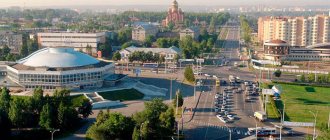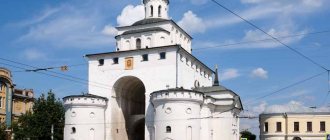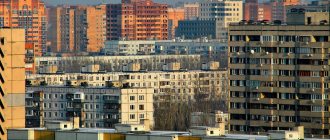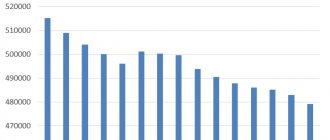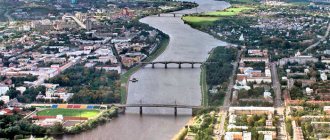| Penza, beginning XXI century |
Penza
, a city in Russia, the administrative center of the Penza region, the cathedral city of the Penza diocese. Population 517.4 thousand (2011)
- On the map: Yandex.Map, Google map
The fortress on the Penza River was founded in 1663 under Tsar Alexei Mikhailovich as an outpost on the southeastern outskirts of the state, which was easy and unprotected prey for the steppe nomads.
In May of that year, Yuri Ermolaevich Kotransky, who was previously the governor of the city of Balakhna, “to build a city,” arrived on the Penza River with a hundred Cherkasy Cossacks. He became the founder and first builder of the city. In a fairly short time, the wooden Kremlin was erected. Responsibilities for creating settlements and fortifications near the fortress were assigned to the voivodeship administration, which was headed from the end of 1663 by the first Penza voivode Elisey Protasyevich Lachinov. By decree of the tsar of October 13, he “built a settlement and settlement in Penza near the city,” that is, he allocated land to the city residents: mounted and foot Cossacks, gunners, and collars. In 1665, the city's population was about 3,300 people (almost 700 households).
For many years, the Penza fortress served as a reliable barrier against the nomads - the Kuban (peoples of the North Caucasus and Azov region) and the Nogai hordes. Penza was attacked by nomads in 1668, 1680 and 1717, but they never managed to capture the fortress. According to legend, in 1717, during the Great Kuban Pogrom, the attackers burned the southern part of the city and had already approached the walls of the fortress, but the Penza residents who were under siege appeared before the enemy army from Kazan with an icon of the Mother of God - a gift from Tsar Alexei Mikhailovich, which saved the city from destruction. The Kazan Icon of the Mother of God is to this day the main shrine of Penza.
In the first third of the 18th century, Penza turned into an internal city of Russia and lost its former strategic importance. In the second half of the 18th century, the Penza region became one of the main areas of landownership in the country. By this time, Penza was a major economic center, the prosperity of which was based on commercial agricultural production (mainly the export of grain) and distillation.
Since 1719, Penza has been the center of the Penza province of the Kazan province. In 1780, the city became the center of the Penza governorship, subordinate to the Kazan governor-general.
On September 9, 1801, Penza was declared a provincial city, being at the same time the center of the Penza district. The governor's residence was located in Penza.
In the 1800s Penza's population was about 13,000 people.
| Penza, view from the cathedral, pre-revolutionary photograph |
In connection with the sharp increase in the administrative apparatus in the provincial Penza, the number of nobles and officials increased significantly, which, together with the opening in the city at the end of the 18th - beginning of the 19th centuries.
educational institutions and its extremely active theatrical and musical life for the Russian province of those years, made Penza a major cultural center. Thanks to the large number of cultural and educational institutions at the turn of the 19th century. Penza was nicknamed “New Athens”. Penza was traditionally located at the intersection of important trade routes, and by the end of the 19th century. received railway access in all directions: on October 11, 1874, traffic began on the Morshansk-Syzran section. This circumstance created good preconditions for economic and cultural development. The epithet of a “merchant” city was firmly assigned to Penza; in the economy of Penza, the leading role belonged to the trade in bread and alcohol and the food industry, especially flour-grinding and vodka.
According to the All-Russian census of 1897, 59,981 people lived in Penza; by 1917, the population was 105,000 people.
On January 3, 1918, Soviet power was established in Penza. In the first post-revolutionary years, Penza found itself in the epicenter of a civil war: peasant uprisings broke out in the villages of the province, and in May 1918, bloody battles took place in the city with the rebel troops of the Czechoslovak corps.
On February 4, 1939, the Penza region was formed. By that time, the city's population was 160 thousand people.
In the first years of the Great Patriotic War, Penza turned into one of the most powerful centers in the country for the production of mortar weapons: on the basis of local and food industry enterprises that existed in the city, equipment from factories evacuated from other cities was deployed.
Religion
Since 1799, Penza has been the cathedral city of the Penza diocese.
Shrines
- Penza Icon of the Mother of God
Monasteries
- Trinity Convent
Temples
- Annunciation of the Blessed Virgin Mary
- Annunciation of the Blessed Virgin Mary, baptismal church
- Holy Spirit of the Descent, Trinity Monastery Church
- Innocent of Irkutsk
- Mitrofan of Voronezh, cemetery
- Michael the Archangel, temple-chapel
- Holy Image, chapel
- Nicholas the Wonderworker
- Peter and Paul
- Intercession of the Blessed Virgin Mary, Cathedral
- Transfiguration of the Lord, ex. Spaso-Preobrazhensky Monastery
- Nativity of Christ, church-chapel
- Sergius of Radonezh, temple-chapel
- Trinity Life-Giving, Church of the Trinity Monastery
- Assumption of the Blessed Virgin Mary, Cathedral
About Penza
Home / City / About Penza
History of the city of Penza
FORTRESS CITY PENZA was founded in 1663 under Tsar Alexei Mikhailovich as an outpost on the southeastern outskirts of the state, which was easy and unprotected prey for the steppe nomads.
In May 1663, Yuri Ermolaevich Kotransky, who was previously the governor of the city of Balakhna “to build a city,” arrived on the Penza River with a hundred Cherkasy Cossacks. He became the founder and first builder of the city. In a fairly short time, the wooden Kremlin was erected.
Responsibilities for creating settlements and fortifications near the fortress were assigned to the voivodeship administration, which was headed from the end of 1663 by the first Penza voivode Elisey Protasyevich Lachinov. By decree of the tsar of October 13, he “built a settlement and settlement in Penza near the city,” that is, he allocated land to the city residents: mounted and foot Cossacks, gunners, and collars. In 1665, the city's population was about 3,300 people (almost 700 households).
E.P. Lachinov was twice appointed Penza governor. Secondly - in 1670. In the same year, he was hanged by a detachment of the Razin ataman Mikhail Kharitonov.
For many years, the Penza fortress served as a reliable barrier against the nomads - the Kuban (peoples of the North Caucasus and Azov region) and the Nogai hordes. Penza was attacked by nomads in 1668, 1680 and 1717, but they never managed to capture the fortress. As a blessing for the newly built city, Tsar Alexei Mikhailovich granted Penza an icon of the Kazan Mother of God, which was considered miraculous. According to legend, in 1717, during the Great Kuban Pogrom, the attackers burned the southern part of the city and had already approached the walls of the fortress, but the Penza residents who were under siege appeared in front of the enemy army with this icon, which saved the city from destruction.
The icon of the Kazan Mother of God is to this day the main shrine of Penza.
In the first third of the 18th century, Penza turned into an internal city of Russia and lost its former strategic importance. In the second half of the 18th century, the Penza region became one of the main areas of landownership in the country. By this time, Penza was a major economic center, the prosperity of which was based on commercial agricultural production (mainly the export of grain) and distillation.
Throughout the 18th century, the administrative status of the city gradually increased. Since 1719, Penza has been the center of the Penza province of the Kazan province. In 1780, the city became the center of the Penza governorship, subordinate to the Kazan governor-general.
In 1781, Penza and the province received the Highest approved coat of arms - three sheaves in a green field: wheat, barley and millet, “signifying the wealth and noble agriculture of the local land.”
On September 9, 1801, by decree of the Senate, Penza was declared a provincial city, being at the same time the center of the Penza district. The governor's residence was located in Penza. The most famous in the field of the Penza governor were: F.L. Wigel (1801 – 1809), G.S. Golitsyn (1811 – 1815), M.M. Speransky (1816 – 1819), A.A. Panchulidzev (1831 – 1859), N.D. Seliverstov (1867 – 1873), P.D. Svyatopolk-Mirsky (1895 – 1898).
In connection with the sharp increase in the administrative apparatus in the provincial Penza, the number of nobles and officials increased significantly, which, together with the opening in the city at the end of the 18th - beginning of the 19th centuries. educational institutions (the main folk school, later the district school; the provincial gymnasium, now the municipal classical gymnasium No. 1; theological seminary; the all-Russian gardening school, now the state farm technical school) and its extremely active theatrical and musical life for the Russian province of those years, made Penza major cultural center. In the 1800s its population was about 13,000 people.
PENZA - NEW ATHENS
The first theater in the city, which existed in 1792 - 1797, was led by the once famous poet and amateur actor, memoirist, Penza vice-governor Prince I.M. Dolgorukov. In the 1st quarter of the 19th century, three theaters operated simultaneously in Penza: the troupe of the rich man Gorikhvostov, which staged Italian operas; troupe G.V. Gladkova, who staged tragedies, dramas and comedies; Governor's troupe V.I. Kozhina.
The current largest theater in the city is the Penza Drama Theater. A.V. Lunacharsky - traces its history back to the Penza Drama Club named after. V.G. Belinsky.
The best symphony orchestra in provincial Russia in the 2nd third of the 19th century was the orchestra of the Penza governor A.A. Panchulidzeva. Of outstanding importance for the culture of the region is the Penza School of Music, one of the oldest in the country, which arose in 1882 as classes of the Penza branch of the Imperial Russian Musical Society, opened a year earlier.
Penza is the birthplace of the Russian circus: in 1873, the city hosted the first performance of a circus owned by Russian entrepreneurs, the Nikitin brothers.
The first art educational institution of Penza and the province - the Makarov school (third quarter of the 19th century); I.K. taught there. Makarov, later academician of painting, author of portraits N.N. Pushkina-Lanskaya and the children of the great poet.
Penza Governor N.D. played a major role in the development of the city’s educational and museum affairs. Seliverstov. He bequeathed 500 thousand rubles to the city. and a collection of books and paintings for the establishment of a school and museum. The art gallery, which opened in 1892, after the creation in 1898 of the Penza Art School named after. N.D. Seliverstova received the status of an art and industrial museum at the school (now it is the regional art gallery named after K.A. Savitsky).
Thanks to the personal assistance of N.D. Seliverstov in 1869 the opening of the Penza girls' gymnasium took place.
In 1891, the first local history museum in the province was opened (under the statistical committee), in 1901 - a scientific archival commission, in 1905 - the Penza Society of Natural History Lovers, and in 1911 - its natural history museum (now the regional local history museum). The most important role in the study of natural conditions, economics and labor resources of the province belonged to the Penza zemstvo (1865 - 1918).
The first public library in the city of Penza was opened in 1837, the library named after. M.Yu. Lermontov - in 1892, a people's library-reading room, which later became the Central City Library named after. V.G. Belinsky - in 1895.
Thanks to the large number of cultural and educational institutions, Penza at the turn of the 19th - 20th centuries. had the proud title of “New Athens”.
The cultural life of Penza has always had certain features that positively distinguished it from Russian provincial cities. In particular, during the years of the last reign, in terms of the number of educational institutions, Penza, inferior to the few university cities at that time, was ahead of most other provincial centers. This feature is a characteristic feature of the city both in Soviet times and today.
ELITE
At the beginning of the 19th century, royalty visited Penza several times. The city was visited by Grand Duke Mikhail Pavlovich (1817), Alexander I (1824), Nicholas I (1836), heir to the throne Alexander Nikolaevich (future Alexander II) (1837). The desire of Nicholas I is associated with the improvement of Cathedral (Soviet) Square, which took place a few years after his visit, including the layout of the city square, which has been called Lermontovsky since 1892. Nicholas I also chose the location for the construction of public charity buildings, consecrated in 1846 (now the N.N. Burdenko Regional Hospital).
ECONOMIC GROWTH OF PENZA
Penza was traditionally located at the intersection of important trade routes, and by the end of the 19th century. received railway access in all directions: on October 11, 1874, traffic began on the Morshansk-Syzran section. This circumstance created good preconditions for economic and cultural development.
Penza had a well-deserved reputation as one of the largest nests of the Russian nobility, personifying the power and glory of the state. Here it was represented by the names of the Sheremetevs, Shuvalovs, Golitsyns, Kurakins, Tatishchevs, Trubetskoys, Dolgorukys, Suvorovs, Vorontsovs, Razumovskys and others.
At the same time, the epithet of a “merchant” city was firmly assigned to Penza. The leading position in the commercial world was occupied by the Karpovs, Finogeevs, Sergeevs, Barsukovs, Kuzmins, Kuznetsovs, Tyurins, Evstifeevs, Ochkins, Pankovs and others, who entered the all-Russian and even world market.
In the 19th – early 20th centuries, the leading role in the economy of Penza continued to belong to the trade in bread and alcohol and the food industry, especially flour-grinding and vodka.
Since the middle of the 19th century, new industries have appeared in the city. The largest of them in pre-revolutionary Penza was a paper mill, established in 1850 by one of the richest merchants in the province, grain merchant P.V. Sergeev (now the Mayak factory).
The first-born of the city's defense industry is the plant for the production of remote tubes for explosive devices (now the ZIF production association), created during the First World War.
The administrative and economic significance of pre-revolutionary Penza determined the relatively rapid penetration of the latest technological achievements into city life: 1845 - the appearance of the daguerreotype (an early method of photographing on a metal plate), 1859 - the telegraph, 1891 - the bicycle, 1897 - the telephone , 1905 - street electric lighting and asphalt sidewalks, 1906 - a car, 1908 - an X-ray room; in 1890, a sound recording apparatus was demonstrated for the first time in Penza, in 1896 - a film, in 1911 - an airplane flight; in 1915, the first Penza cinema "Olympus" (now "October") was opened.
SOVIET AUTHORITY IN PENZA
According to the All-Russian census of 1897, 59,981 people lived in Penza.
As a result of the intensive development of the city at the beginning of the twentieth century. its population by 1917 was 105,000.
In a wartime environment, the most favorable conditions for revolutionary propaganda developed in large industrial enterprises and railways, in military units and educational institutions, which produced tangible results in Penza. At the same time, the majority of residents of the region did not support the Bolsheviks, giving preference, as elsewhere in Russia, to other left-wing political parties. In Penza, the prologue to the revolution that broke out in the country in 1917 was the murder of the garrison commander, Major General Bem, which took place on March 10 at a parade of troops in honor of the Freedom Day, 8 days after the abdication of the last Emperor in Russia, Mikhail Alexandrovich.
On January 3, 1918, Soviet power was established in Penza.
In the first post-revolutionary years, Penza found itself in the epicenter of a civil war: peasant uprisings broke out in the villages of the province, and in May 1918, bloody battles took place in the city with the rebel troops of the Czechoslovak corps. A monument to these tragic pages in the history of Penza is the necropolis on Sovetskaya Square, where Penza residents who defended their city are buried.
In the years before the Great Patriotic War, the production base was further developed: a confectionery, knitting, sewing, biscuit factories, a soft drink factory and a calculating machine factory were built, and the production of bicycles and wristwatches began.
At the same time, the educational, medical and cultural infrastructure was improved and expanded. In Penza, forestry, pedagogical, industrial, construction and other technical schools, a teacher's institute, children's and infectious diseases hospitals, an anti-tuberculosis clinic were created, and a maternity hospital was organized.
FOUNDATION OF THE PENZA REGION
On February 4, 1939, the Penza region was formed. By that time, the city's population was 160 thousand people. At the same time, the Penza Railway was formed, which later became part of the Kuibyshev Railway.
In the first years of the Great Patriotic War, Penza turned into one of the most powerful centers in the country for the production of mortar weapons: on the basis of local and food industry enterprises that existed in the city, equipment from factories evacuated from other cities was deployed.
More than 200 Penza residents were awarded the title of Hero of the Soviet Union. Among them is A.A. Krasnov, N.S. Pavlushkin, A.I. Merenyashev, G.V. Ternovsky and others. The labor feat of the residents of Penza was also awarded by the Motherland: the bicycle factory - the Order of Lenin, the watch factory - the Order of the Patriotic War. For its great contribution to ensuring victory in the Great Patriotic War, Penza was awarded the Order of the Red Banner of Labor in 1985.
Modern Penza is a large center of Russia with a well-developed infrastructure and rich cultural traditions.
Each city has a purely individual source of pride. The history of Penza took shape under a constellation of brilliant names: writers - V.G. Belinsky, M.Yu. Lermontova, P.A. Vyazemsky, D.V. Davydova, M.E. Saltykova-Shchedrin; composers - A.A. Arkhangelsky, O.V. Grishina; directors - V.E. Meyerhold, S.M. Reingold; doctors - N.F. Filatova, G.A. Zakharyina, N.N. Burdenko; scientists - F.I. Buslaeva, V.O. Klyuchevsky; singers - A.A. Yakhontova, A.I. Mozzhukhina; artists - K.A. Savitsky, I.S. Goryushkina-Sorokopudova, A.V. Lentulova, V.E. Tatlin; filmmakers - I.I. Mozzhukhina, V.I. Pudovkina, M.A. Schweitzer; military leader M.N. Tukhachevsky; cosmonaut V.I. Patsaeva. The history of Penza and the memory of these people are immortalized in the exhibitions of the State United Museum of Local Lore, the art gallery named after. K.A. Savitsky, museums V.O. Klyuchevsky, N.N. Burdenko and V.E. Meyerhold, Literary Museum.
Great figures of Russian culture and the Penza region
“The whole history of Russia is in Penza...” the poet Yevgeny Yevtushenko said about our city. And indeed it is. The names of one and a half thousand figures of Russian culture are associated with the history of the Penza region. Let's name some of them.
Arkhangelsky Alexander Andreevich
- composer and choral conductor - originally from the village of St. Tezikovo, Narovchatsky district, Penza province. Born October 11 (Old Style), 1846. A graduate of the Penza Theological Seminary, he showed outstanding musical abilities from a young age. This allowed him to subsequently brilliantly pass the exam for the title of regent at the Court Singing Chapel of St. Petersburg.
In 1880, Arkhangelsky organized his own choir, consisting of 75 people, which in a short time took a dominant position in the cultural life of the northern capital. For forty-three years, Alexander Andreevich led the choir. His series of “historical concerts,” which included choral music of various directions and styles from Palestrina to Bach, brought him worldwide fame.
Reformism A.A. Arkhangelsky was that female voices were heard for the first time in his choir, and that he introduced classical techniques of secular music into the interpretation of sacred works. All this extremely enriched the sound palette and further expanded the boundaries of the performing capabilities of the academic choir.
In 2002, the name of Alexander Andreevich Arkhangelsky was assigned to the Penza Music School to commemorate the 120th anniversary of its founding.
Belinsky Vissarion Grigorievich
- an outstanding literary, theater critic and publicist - was born on May 30, 1848 in Suomenlinna (Finland) in the family of a naval doctor. He graduated from the Chembarsky Public School and studied at the Penza Gymnasium. He entered Moscow University, from which he was soon expelled. He worked in the Moscow and St. Petersburg magazines “Telescope”, “Moscow Observer”, “Domestic Notes”, “Sovremennik”. Belinsky wrote about 1,100 articles and reviews. He laid the foundation not only for the theory of literature and theater criticism, but also for the history of Russian literature, defining the periods and directions of its development; the theory of literature as a scientific discipline, substantiating the concepts of genera and types, genres, and the specifics of artistic creativity; aesthetics, defining its main categories, the concept of national art. The ideas of Vissarion Grigorievich Belinsky about patriotism and humanism of Russian literature and art contributed to the development of the spiritual culture of society. He educated and educated the Russian reading public, many generations of whom owe their enlightenment and cultural development to him. More than one generation of Russian radical figures was brought up on Belinsky’s revolutionary-democratic ideas.
Klyuchevsky Vasily Osipovich - historian, teacher - was born on January 16, 1841 in the village of Voskresenovka, Penza district, in the family of a rural priest. My childhood years were spent in the Penza province. He studied in Penza at a parish theological school, a district theological school, and a theological seminary. Graduated from Moscow University. He was left at the department to prepare for the professorship. He began teaching, which brought him fame, in 1967 and continued until the end of his life. Vasily Osipovich Klyuchevsky had a strong influence on the contemporary and further development of the history of science, and created a large scientific school. His “Course of Russian History” gained worldwide fame.
On the occasion of the 150th anniversary of the historian’s birth in 1991, the V.O Klyuchevsky House Museum was opened in Penza. In recognition of the scientist’s merits, the International Center for Minor Planets (Smithsonian Astrophysical Observatory, USA) assigned planet No. 4560 the name of Klyuchevsky.
Mikhail Yurievich Lermontov is a great Russian poet, prose writer, and playwright. Born October 3, 1814 (according to the old style) in Moscow. Since 1815 (that is, half of his life) he lived in the family estate of Tarkhany, Penza province, with his grandmother E.A. Arsenyeva. In 1828 he entered the Moscow University Noble Boarding School, and in 1830 - the Moscow University, from where he soon left and entered the school of guards ensigns and cavalry cadets. In November 1834 promoted to cornet of the Life Guards Hussar Regiment. On December 31, he goes on vacation to Tarkhany, where he works on the drama “Two Brothers,” the poem “Demon,” “Song about the Merchant Kalashnikov,” and the poem “Tambov Treasurer.” The poem “The Dying Gladiator”, etc. This was his last visit to his native place. In 1837 for the poem “Death of a Poet” he was sent into exile in the Caucasus. Sent to the Caucasus for the second time into exile in 1840. Having settled in Pyatigorsk for treatment, he met with his previously familiar fellow countryman N.S. Martynov. As a result of a quarrel with him, a duel took place, in which M.Yu. Lermontov was killed. The poet's ashes rest in the chapel of the Tarkhan estate.
Official website of the museum-estate "Tarkhany" https://www.tarhany.ru/
Mozzhukhin Ivan Ilyich - a great silent film actor - was born on September 26, 1889. in the village of Kondol, Petrovsky district, Saratov province, now the regional center of the Penza region.
He studied at the 2nd Penza Men's Gymnasium, became interested in theater, and participated in productions of the Penza People's Theater.
In 1908 he began acting in films. He gained fame after playing the role of Trukhachesky in the film “The Kreutzer Sonata”. In 1920 emigrated.
Filmed mainly in France. Buried in Paris.
In 1990 The memorial museum of Ivan Ilyich Mozzhukhin was opened in Kondol.
Meyerhold Vsevolod Emilievich , a great director and actor of our time, was born on January 28, 1874 in Penza into a merchant family. I became interested in theater at an early age. He studied at the 2nd men's gymnasium. Participated in amateur performances. Leaving for Moscow does not break his connection with Penza.
Meyerhold worked as an actor at the Moscow Art Theater and headed the New Drama Association. Summer of 1904 created his own theater, which served as the basis for the formation of an artistic program associated with the poetics of symbolism, with the principles and style of conventional theater.
After the revolution of 1917 Meyerhold actively participates in the work of the Theater Department of the People's Commissariat of Education. In 1921, he organized the State Higher Director's Workshops (on the basis of which GITIS was created a year later), and with them a theater. In 1923 it gets the name – Theater named after Vs. Meyerhold (TIM). From 1934 to 1937 Meyerhold staged performances based on plays by Russian and Soviet playwrights in the bright, spectacular form characteristic of the stage reformer. After the closure of GosTIM in 1938. Meyerhold worked at the State Opera House. K. Stanislavsky. Summer 1939 he was arrested, and on the night of February 2-3, he was shot in Butyrka prison. In 1984 The Museum of Performing Arts named after. Vs. Meyerhold.
In 1999, Penza erected the first monument to Vsevolod Emilievich Meyerhold in Russia. It was made by Penza sculptor Yu.E. Tkachenko. A great director takes the stage and looks back at those behind the scenes. We see the monument from behind the scenes, Meyerhold leaves us - onto the stage, into his art.
The material was prepared by specialists from the Central City Public Library named after. V.G. Belinsky
print version
Popular message topics
- City of Barnaul
Barnaul is a small city located in the south of Western Siberia, on the banks of the Ob River. There are several versions of the appearance of the city's name. According to one of them, the word is translated from the Kazakh language as “good camp”. - Calla flower
Calla is a beautiful flower that will surprise anyone with its incredible beauty. This is a plant that belongs to the Araceae family. It has an unusual, sometimes even bizarre shape. You can find a lot of shades of this plant. - Indian culture
Indian culture is one of the oldest in the world and dates back about 4,500 years. The country has made significant achievements in architecture, mathematics and medicine. Language, religion, food and art are some of the components of Indian culture.
Population in municipal, urban areas
Penza is located in the center of the European part of Russia on the Volga Upland.
The length of the city from north to south is 19.3 km, from west to east – 25.3 km.
In addition to the Sura (the main water artery of the city), the rivers Penza, Penzyatka, Ardym, Staraya Sura, Moika, Barkovka, and the Prokop and Bezymyanny streams flow through the city. Some of them within the city partially flow in sewers.
The climate of Penza is moderate continental.
Now we will tell those interested in the climate in the city of Penza, what the average temperature was according to research over the past few years, the maximum and minimum values, as well as the average and norms of precipitation:
Penza city climate (weather, precipitation)
| Index | Jan. | Feb. | March | Apr. | May | June | July | Aug. | Sep. | Oct. | Nov. | Dec. | Year |
| Abs. Max. | 7,0 | 8,5 | 17,3 | 31,1 | 35,6 | 37,7 | 39,3 | 40,4 | 33,6 | 25,6 | 16,1 | 11,0 | 40,4 |
| Avg. Max. | −5,5 | −5,1 | 1,0 | 12,4 | 20,8 | 24,8 | 26,6 | 24,7 | 18,2 | 9,9 | 0,6 | −4,4 | 10,3 |
| Avg. pace. | −8,7 | −9,1 | −3,4 | 6,8 | 14,3 | 18,5 | 20,4 | 18,3 | 12,5 | 5,6 | −2,1 | −7,4 | 5,5 |
| Avg. min. | −11,9 | −12,5 | −7,2 | 1,9 | 8,1 | 12,7 | 14,7 | 12,8 | 7,7 | 2,2 | −4,6 | −10,3 | 1,1 |
| Abs. min. | −39,9 | −40 | −31,1 | −20 | −5,6 | −1,1 | 4,7 | 0,0 | −6,4 | −17,2 | −31,1 | −40,5 | −40,5 |
| Norm of siege. | 38 | 31 | 35 | 33 | 42 | 65 | 59 | 51 | 52 | 47 | 48 | 41 | 542 |
Whether the population of the city of Penza is decreasing or increasing, what is its official number according to the census as of January 1, 2022, in its municipalities, urban areas, we will learn about this later, when accurate information appears, for now we will present the currently available figures.
Founding date of Penza: 1663
Time zone: MSK, UTS +3
Project on the theme “My hometown is Penza” for 2nd grade
Goal of the project: As part of studying the subject “The World Around You,” talk about your hometown, its attractions and memorable places.
Find information about his story and share it with your classmates. Tell schoolchildren about Penza and why I love it. Prepare a report and presentation in the form of a photo story. Project plan:
- Location on the country map.
- History and symbols.
- Penza in the present.
- Attractions.
- Places of military glory.
- Conclusion.
- An example of a finished photo story-presentation.
Coat of arms
The coat of arms of Penza is presented in the form of a French shield. The ratio of width to height is 4:5. It depicts (in a green field) three golden sheaves: wheat, barley and millet. They stand on the ground the color of the same precious metal and indicate the wealth and agriculture widespread in the area.
The artistic composition was adopted by the decision of the Penza City Duma of December 28, 2001 No. 186/13. Borrowed from the emblem of the Penza regiment. Included in the State Heraldic Register of the Russian Federation under No. 972.






